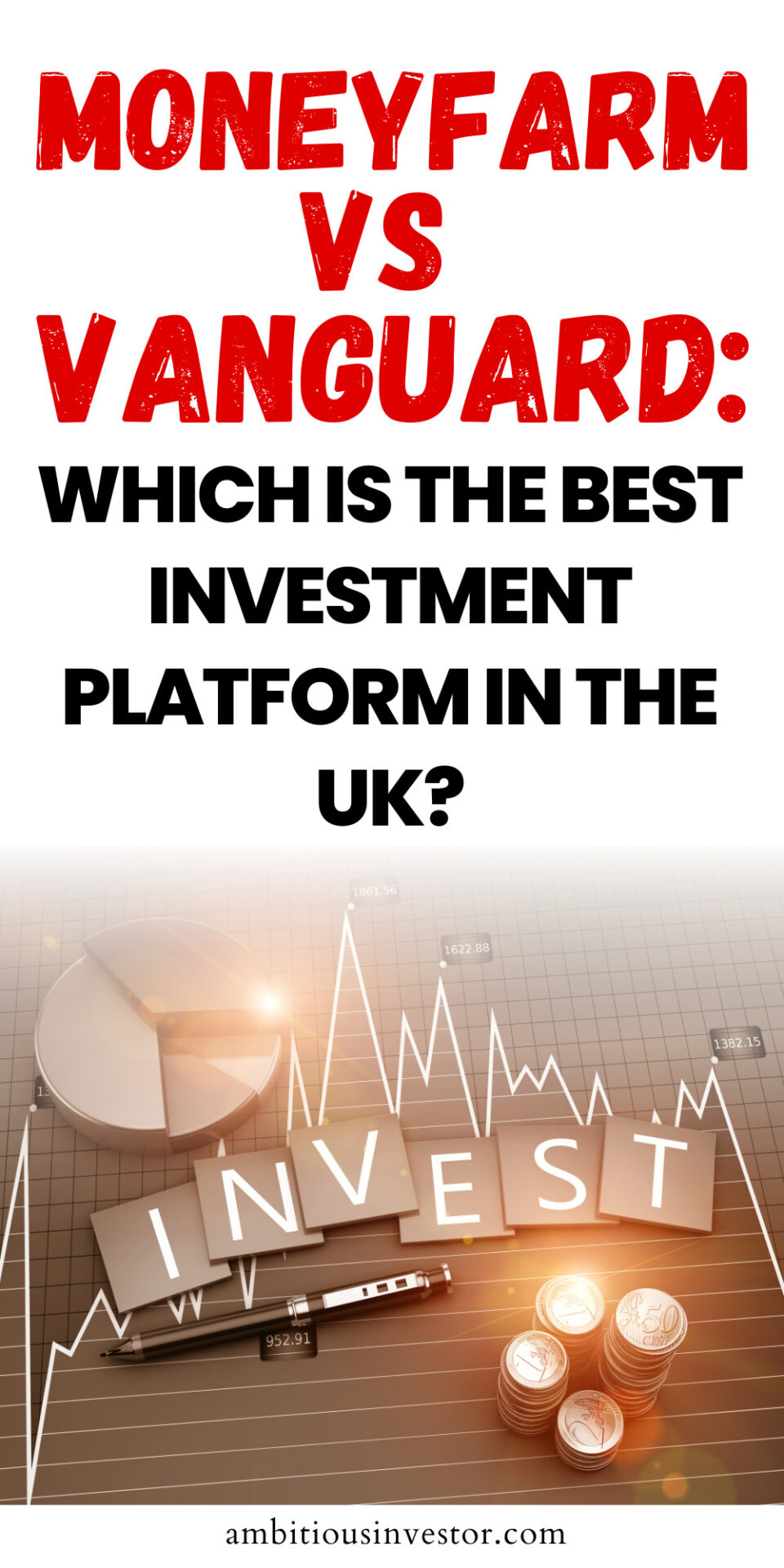Moneyfarm vs Vanguard: Which Is the Best Investment Platform in the UK?
Are you considering Moneyfarm and Vanguard as your potential investment platforms? Both are reputable and popular investment platforms for UK investors. And each claims to offer the best returns, fee structures, and overall services. However, one might be better suited to your investment goals, risk appetite, and preferences than the other.
How do you decide which investment platform is right for you? That’s what this quick and easy guide to Moneyfarm vs Vanguard is all about! We’ll take a closer look at each platform to help you decide where to invest your hard-earned money and achieve your investment goals.
Moneyfarm: Best for Beginners Looking for a Robo-Advisor
✔️ FSCS protection and FCA regulated
✔️ Fully automated managed portfolios
✔️ Easy to use mobile app
✔️ £500 minimum investment
✔️ Offers ISAs
Vanguard UK: Best for Experienced Investors and Long-Term or Retirement Savers
✔️ FSCS protection and FCA licensed
✔️ Managed and DIY portfolios
✔️£500 minimum investment or £100 monthly installments
✔️ Offers ISAs
✔️ Lower fees
Visit Vanguard Now
Moneyfarm vs Vanguard in a Nutshell
Moneyfarm Overview
Established in 2011, Moneyfarm is one of Europe’s largest online wealth management companies. It uses technology (robo-advisors) to create and manage clients’ investment portfolios. It’s regulated to offer investment advice.
The managed portfolio service makes investing easier by removing the burden of researching the markets and making investment decisions. This makes Moneyfarm ideal for new and experienced investors without much time to spare.
Vanguard Overview
Vanguard is a long-standing asset management firm established in 1975. It has over 30 million clients worldwide and is known for attracting long-term ETF and mutual funds investors.
Vanguard offers both managed and DIY portfolios. The managed portfolios are designed from their own funds and are ideal if you prefer a hands-off approach to investing. With the DIY portfolios, you have to select your own investments from the available Vanguard funds. That’s a good option for someone who prefers to make their own investment decisions.
The main difference between them is that Moneyfarm offers only a managed portfolio service while Vanguard offers a managed and DIY portfolio service.
Moneyfarm vs Vanguard: Account Options
As a UK investor, you should take advantage of the tax-free account options in the country. These accounts include:
- Stocks and Shares ISA: Invest tax-efficiently up to £20,000 annually each tax year (from 6 April to 5 April). Your money grows tax-free, but you can only invest in one Stocks and Shares ISA per tax year.
- Self-Invested Personal Pension (SIPP): This is a tax-efficient way to save for retirement. It allows you to claim tax relief on contributions on your earnings, up to £60,000 annually.
- Junior ISAs: Invest in your child’s future to give them a headstart. Returns are free from income and capital gains tax.
Both Moneyfarm and Vanguard offer all three ISA account options. They also offer a general investment account (GIA), allowing you to invest without limitations on annual contributions. However, general investment accounts have no tax-free benefits.
In other words, Moneyfarm and Vanguard are similar in terms of account options.
However, Vanguard offers two options for the Stocks and Shares ISAs: managed and DIY portfolios. With the managed ISA, Vanguard matches you with suitable investments and manages them for you. The DIY option allows you to choose from 80+ individual funds to build your own investment portfolio.
Moneyfarm vs Vanguard: Account Opening Process
Both platforms offer a simple account opening process.
Monefarm starts by asking a few questions to determine your investor profile and recommend a suitable portfolio. You can then open the recommended portfolio and invest when you’re ready. Moneyfarm’s minimum investment is £500.
With Vanguard, you must first decide on the right account. Do you want a Stocks and Shares ISA or a general investment account? You can then choose your funds (managed or DIY) and decide how much to invest. Vanguard’s minimum investment amount starts from £100 a month or a one-off £500.
Moneyfarm vs Vanguard Portfolios
The biggest difference between Vanguard and Moneyfarm is their approach to investment options. Moneyfarm is a robo-advisor service, while Vanguard gives investors more control of their investments.
Let’s look at what you can expect from Moneyfarm and Vanguard’s portfolios.
Moneyfarm Investment Options
Moneyfarm offers seven specially designed portfolios. These portfolios are made up of global equities, corporate bonds and commodities. The company provides information about each portfolio’s past performance on its website. However, past performance is not an indicator of future performance.
Remember Moneyfarm offers a fully managed portfolio service? That means you cannot choose, manage, or rebalance a portfolio of your choice. Instead, Moneyfarm uses your investor profile (from the answers you give during account setup) to match you with the most fitting portfolio.
If you don’t believe the portfolio Moneyfarm matched you with is ideal, you can discuss options with the firm’s investment advisors.
Moneyfarm offers two portfolio management options:
- Actively managed portfolios: Moneyfarm monitors these investments and regularly rebalances your portfolio to take advantage of market performance.
- Fixed allocation portfolios: The investments follow the markets with one yearly portfolio rebalancing.
Vanguard Investment Options
Vanguard offers 80+ individual funds and several ready-made portfolios. Unlike Moneyfarm, you have to pick to manage your own investments with Vanguard.
- Individual funds: These investment funds are a collection of assets that invests in stocks, bonds, and other securities. If you want to build your portfolio, you can select one or more funds that match your investment goals and risk profile.
- Ready-made portfolios: Vanguard offers two sets of ready-made portfolio categories: LifeStrategy, which has five types of categories and Target Retirement, which contains 11 templates to choose from. Both LifeStrategy and Target Retirement funds are actively managed funds.
Creating a DIY portfolio is a good option for experienced investors willing to research and understand the markets. Vanguard also offers a simple six questions questionnaire to help you understand your investment risk profile. You’ll then get a suggestion of funds, but the end choice is yours.
You can also select the managed Shares and Stocks ISA account if you want a fully managed portfolio with Vanguard. You just need to answer a few questions, and Vanguard will match you with a ready-made portfolio. The experts will monitor your investments monthly and rebalance your portfolio as needed.
With Moneyfarm, everything from selecting your investments and rebalancing your portfolio is handled for you, regardless of the account. However, with Vanguard, you need to make your own investment decisions unless you’re using the managed Shares and Stocks ISA.
Vanguard vs Moneyfarm: Ethical Investments
Are you interested in ethical investing? An ethical investment allows you to align with your values and beliefs.
Both Moneyfarm and Vanguard offer ESG (environmental, social, governance) investing. Moneyfarm ethical ISA growth portfolios are made of exchange-traded funds (ETFs). Vanguard also offers a good range of ESG funds to build a portfolio.
Moneyfarm vs Vanguard: Fees
You cannot evaluate an investing platform without considering the fees. They determine how much of your investment returns you keep each year. Even seemingly low fees can add up and affect your portfolio’s total value.
Both Moneyfarm and Vanguard have clear fee structures but let’s take a closer look.
Moneyfarm Fees
Moneyfarm charges a management fee based on the value of your investments. The fees decrease with larger portfolios.
The table below shows Moneyfarm’s management fees based on portfolio size and type.
| Invested Amount (from) | Fees (Actively Managed Portfolio) | Fees (Fixed Allocation Portfolio) |
|---|---|---|
| €500 | 0.75% | 0.45% |
| €100k | 0.45% | 0.35% |
| €250k | 0.40% | 0.30% |
| €500k | 0.35% | 0.25% |
You will also pay an average of 2% underlying fund fee and a market spread of up to 0.10% annually.
Vanguard Fees
Here’s a breakdown of the fees to expect with Vanguard.
- Annual account fee: You’ll pay 0.15% for a portfolio worth €0 to €250,000. Vanguard caps the fees at €375 if the invested amount is over €250,000.
- Investment fund fee: You’ll pay a 0.22% to 0.24% management fee for ready-made portfolios and 0.06% to 0.78% if you choose individual funds.
- Fund transaction costs: Vanguard charges transaction fees when buying or selling funds. Ready-made portfolio fees are 0.02% to 0.09%, and individual funds are 0.01% to 0.89%.
- One-off costs for exchange-traded funds: 0.03% to 0.45%
How do Vanguard and Moneyfarm fees compare? Moneyfarm management fees range from 0.35% to 0.75%, while Vanguard charges 0.15%. Most of Vanguard’s funds are also low-cost.
Vanguard fees are much lower compared to Moneyfarm. But remember, with Vanguard, you’ll have to make more investment decisions while Moneyfarm does it all for you.
Financial Services Compensation Scheme (FSCS) Protection
Vanguard and Moneyfarm are licensed and regulated by the Financial Conduct Authority (FCA). They are also covered by the Financial Services Compensation Scheme (FSCS) protection up to the first £85,000.
Moneyfarm vs Vanguard: Ease of Use
You can access Moneyfarm via their website or app. Since the firm handles everything for you, it’s one of the simplest investing platforms you can use. All you have to do is fill out the simple initial questionnaire, select which account you’d like, and top up your account.
There are no special features to worry about. And if you’re stuck, Moneyfarm has investment experts to guide you over the phone or email. Using the mobile app, you can monitor your investment performance and other details on the go.
Vanguard is more of a traditional investment company. Their platform is accessible via the website. There’s no mobile app yet. However, using the site is also quite easy, especially for experienced investors who understand investment funds.
Moneyfarm vs Vanguard: Investor Education
Understanding your investments is crucial for long-term success. Even if you opt for a robo-advisor service, it pays to understand how investing works. Moneyfarm has a blog with market updates and basic investing articles.
Vanguard also offers quality investor resources and education. These resources are best suited for beginner and intermediate investors.
Moneyfarm vs Vanguard: Customer Reviews
What is the overall customer satisfaction? We checked the TrustPilot rating to find out.
Vanguard has a good rating of 4.1/5 from about 2,400 reviews. Most customers highlight outstanding customer service and low fees.
On the other hand, Moneyfarm has a rating of 3.6/5 from about 830 reviews.
Moneyfarm vs Vanguard: Quick Comparison
Here’s a quick comparison of Moneyfarm and Vanguard UK.
| Feature | Moneyfarm | Vanguard |
|---|---|---|
| Investment option | Managed | Managed and DIY |
| Minimum investment | €500 | €100/month or €500 one-off |
| Fund fees | 0.35%-0.75% | 0.15% and a max of €375 |
| Investment advice | Yes | Yes |
| FSCS protection | Yes | Yes |
| Mobile app | Yes | No |
| Number of
Portfolio Types |
Seven | 16 |
| Socially responsible option? | Yes | Yes |
| Trust Pilot score | 3.6 | 4.1 |
Bottom Line
Have you chosen a winner that suits your investment style and financial goals yet? Do you want a fully managed portfolio or you’d rather build your own?
Moneyfarm is a robo advisor that handles the investments on your behalf. It’s ideal if you don’t want to control your investments or don’t have the time.
On the other hand, Vanguard offers more control and more investment funds to choose from. It’s ideal if you know what you’re doing or have an investment consultant. However, you can also choose managed shares and stocks ISA and leave the work to the experts.
Regarding fees, Vanguard is cheaper compared to Moneyfarm. It also appears to have better overall customer satisfaction based on Trustpilot’s ratings.










